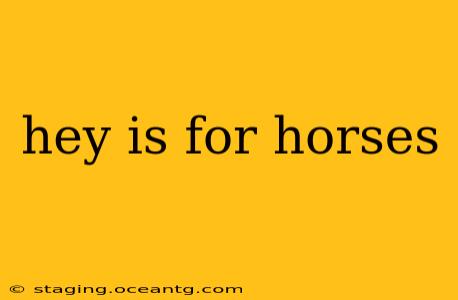Hey! What Does "Hey" Mean, and Why Is It Used for Horses?
The phrase "Hey" for horses isn't a universal rule, but it's a common practice among many horse handlers and riders. While there's no definitive historical record explaining its origin, several factors contribute to its popularity and effectiveness. This isn't about some secret horse language, but rather a combination of sound, meaning, and practical considerations.
Why Do People Say "Hey" to Horses?
This seemingly simple sound has several advantages when interacting with horses:
-
Short, Sharp, and Attention-Grabbing: Horses have excellent hearing. A sharp "Hey" cuts through other noises and immediately grabs their attention, particularly in potentially distracting environments like stables or pastures. It's less jarring than a loud shout and less likely to startle or frighten a sensitive animal.
-
Neutral Tone: Unlike commands like "Whoa!" or "Giddy-up!", which have specific meanings, "Hey" acts as a general attention-getter. It doesn't pre-suppose any particular action from the horse. This is useful for situations where you just need to get their attention before giving a more precise instruction.
-
Versatile Use: You can use "Hey" in various scenarios: to get a horse's attention before approaching, to alert it to your presence, to redirect its focus, or even as a gentle reprimand if it's misbehaving mildly.
-
Consistent Sound: The simplicity of "Hey" allows for consistent use and recognition. Different people might pronounce commands differently, leading to confusion. "Hey" is less prone to such variations.
What Other Sounds Do People Use for Horses?
While "Hey" is prevalent, people use various sounds and calls depending on their relationship with their horse, the situation, and their personal preferences. These can include:
- Clicking sounds: Often used for positive reinforcement and training.
- Whistles: Can be used to attract a horse's attention from a distance.
- Soft vocalizations: Gentle humming or murmuring can soothe and calm a nervous horse.
- Specific commands: These vary greatly depending on the discipline (e.g., "Whoa" for stopping, "Walk on" for continuing).
Is There a "Horse Language"?
While horses don't communicate using human language, they understand and respond to various vocalizations, body language, and even the subtle vibrations of their human companions. Understanding equine behavior and using appropriate communication is vital for building trust and ensuring safe interaction.
How Do I Effectively Communicate With My Horse?
Building a strong, trusting relationship with a horse requires understanding its needs and communicating clearly and consistently. Pay attention to its body language—ears, tail, and overall demeanor—to gauge its mood and reaction to your communication. Seek advice from experienced horse handlers or trainers if you need help understanding equine communication. Remember, consistent positive reinforcement is key to building trust and ensuring safe and successful interaction.
In summary, while "Hey" might not be a formal command, its usefulness as a simple, effective attention-getter makes it a practical tool for many horse handlers. The real key to interacting effectively with horses is learning to read their cues and understanding how to communicate with them in a manner that builds trust and mutual understanding.
